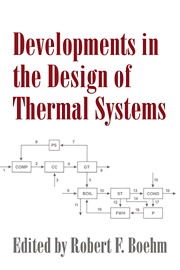Book contents
- Frontmatter
- Contents
- Preface
- Biographical sketches of the authors
- 1 Introduction and trends in the thermal design field
- 2 Computer-aided process design trends in the power industry
- 3 Automated design of chemical process plants
- 4 Thermophysical properties for design simulations
- 5 Introduction to Pinch Analysis
- 6 Second Law applications in thermal system design
- 7 Thermodynamic optimization of heat transfer and fluid flow processes
- 8 An introduction of thermoeconomics
- 9 Artificial intelligence in thermal systems design: concepts and applications
- Subject Index
- Author Index
3 - Automated design of chemical process plants
Published online by Cambridge University Press: 23 September 2009
- Frontmatter
- Contents
- Preface
- Biographical sketches of the authors
- 1 Introduction and trends in the thermal design field
- 2 Computer-aided process design trends in the power industry
- 3 Automated design of chemical process plants
- 4 Thermophysical properties for design simulations
- 5 Introduction to Pinch Analysis
- 6 Second Law applications in thermal system design
- 7 Thermodynamic optimization of heat transfer and fluid flow processes
- 8 An introduction of thermoeconomics
- 9 Artificial intelligence in thermal systems design: concepts and applications
- Subject Index
- Author Index
Summary
Principal activities in design
With its roots in research and development, the design of chemical process plants is prompted by new chemical science, expanding or evolving markets for chemically derived products or intermediates, or a need to retrofit existing facilities. Retrofitting may be influenced by environmental regulation or simply a need to make plants more energy-efficient.
The steps involved in the life-cycle ownership and stewardship of a manufacturing facility are shown in Table 3.1.
A more formal representation of the activities briefly summarized in Table 3.1 has recently been prepared at the University of Missouri-Rolla in conjunction with the American Institute of Chemical Engineers, Process Data Exchange Institute (PDXI) (Book et al., 1994). An activity model based on the US Air Force (1981) ICAM Architecture (IDEFO) was completed for the front-end design activities, commonly referred to as the process engineering phase of process design. The objective of PDXI has been the design of a data exchange protocol for the sharing of data among the various organizations and groups involved in the engineering of chemical plants.
An activity model for process engineering
The top level view of the activity model is shown in Fig. 3.1. The entities that enter from the left of the diagram indicate the materials and intellectual property that will be employed in the design and operation of the process.
- Type
- Chapter
- Information
- Developments in the Design of Thermal Systems , pp. 40 - 75Publisher: Cambridge University PressPrint publication year: 1997

